Characterization and mechanism analysis of AgBr mixed cuboid WO3 rods with enhanced photocatalytic activity
Abstract
Cuboid rods of monoclinic WO3 (m-WO3) were successfully prepared by employing preoxo-polytungstic acid as the precursor via a hydrothermal method. AgBr/m-WO3 photocatalysts with varying loadings of AgBr were synthesized and characterized by X-ray diffraction (XRD), scanning electron microscopy (SEM). Photocatalytic degradation of rhodamine B (rhB), methyl orange (MO) and methyl blue (MB) were carried out to evaluate the photocatalytic activity of AgBr/m-WO3 under visible-light irradiation (λ ≥ 420 nm). Among such catalysts, the AgBr (30 wt%)/m-WO3 exhibits the highest visible-light-responsible photoactivity. However, these AgBr/m-WO3 materials gradually lost their photoactivity in the cycling photocatalytic tests. Possible mechanisms for both the enhance photocatalytic activity and deactivation of the AgBr/m-WO3 were proposed on basis of theoretical speculation and experimental observations.


 Please wait while we load your content...
Please wait while we load your content...